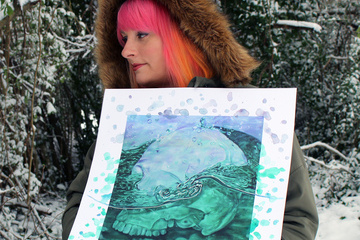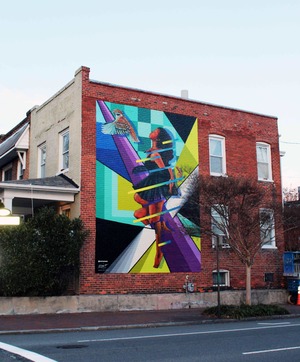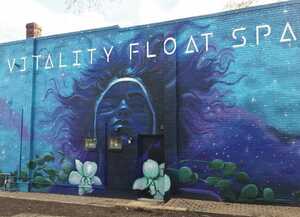
03/19/2021
Nico Cathcart ’08 is coming home to use her skills to beautify the City of Cortland this summer.
Cathcart, an artist and muralist from Richmond, Va., has explored topics such as intersectional feminism and climate change in her art. She was recognized as an “Agent of Change” by the Virginia Museum of History and Culture in 2020 and her work in on display there, the Hermitage Museum in Norfolk, MASS MOCA and in many public places across the U.S.
In 2019, Cathcart delivered a talk at a TEDx Talk event in Richmond, speaking about the responsibility of public art, as well as her hearing loss, which she first realized shortly after graduating from Cortland, noticing she couldn’t hear chirping birds anymore.
“I paint birds as a reminder to myself to not to take things for granted,” she said. “Also, as a symbol for resilience. If I can get through this, I can get through anything.”
Three local business — Catalpa Flower Farms, Food & Ferments and Main Street Farms — have asked Cathcart, a graduate of nearby Homer (N.Y.) High School, to paint an agricultural-themed mural on the façade of their warehouse on Main Street in Cortland this summer.
Cathcart answered a few questions for SUNY Cortland's alumni newsletter, Red Dragon Tales, below. To see more of her work, follow her on Instagram at @nicocathcart.
RDT: What made you want to study art at SUNY Cortland? Was there anything you learned during your time on campus that pushed you toward murals and public art?

NC: “I started out in the SUNY Oswego BFA program and ended up moving back to Cortland. The program was a great way to complete my education. I was very lucky to have been at the school when it received BFA accreditation, which allowed me to be one of the first BFAs to graduate from the program. I had many professors that helped me out during the program that I still keep up with today. Kathy Kramer and I had an ongoing dialog about contemporary art which helped me think about how I frame my work, and what it means. I also took a wonderful course on Michelangelo’s Sistine Chapel, which I have admired since I was copying its figures while learning to draw as a child. Many people view murals as a purely contemporary form of art, but when you go back in art history, you see it's one of the oldest, most accessible forms of art. My senior thesis was all about symbolism throughout history being made current, which is a theme I still work with.”
RDT: Will it be nice to come home and do something in Cortland?
NC: “Absolutely! This piece this summer will be my third mural in the state. I did the international, invitational WALL\THERAPY in Rochester in 2018. This particular one is a little bit of a homecoming. It will be mere blocks away from SUNY Cortland but also very near where I went to high school. I will be able to stay with my parents, whom I haven't seen since the onset of COVID, which is really important to me. I also am excited to be able to bring what I do back home and create a community conversation about public arts and the inherent value in them.”
RDT: Main Street Farms announced that it is looking for a vegetable and flower theme for this mural. Do you have a vision for what the final product will look like?
NC: “While I am not at liberty to discuss design just yet, I can talk a little about the theme. The businesses who use the building are all local and agriculturally based. We have discussed the importance of sustainable agricultural practices as well as the role the critically endangered pollinators, such as bees and butterflies, play in local food production. While we will absolutely be focusing on the plants grown by these farms, there will be a wider theme about why these types of small business farms are so important. Many of my murals, like most of my canvas work, deal with climate change and how humans are connected to the environment. It's a natural progression to talk about sustainable agriculture and pollination for this mural.”
RDT: There was a resurgence of discussion of public art following many cities painting Black Lives Matter on streets last summer. Do you see a future with more murals on important topics?

NC: “Public art has always been a part of communities, from the moment humans picked up charcoal and started drawing livestock on walls. What I think is happening with the larger zeitgeist is that people are realizing that public art is a great way to begin to talk about conversations we need to have as a society. Many artists have already been working in this way, well before those yellow words went down on the pavement in Washington, D.C. I think in times of great differences, it is the responsibility of the public artist to create work that talks about the issues. This, culturally, makes a big impact. Art has a lot of power to transcend past the heavy media headlines, and complex issues to delve into the human condition in a way everyone can understand. Public art is an intervention into real life that everyone can benefit from. I think it's a wonderful thing.”
RDT: It must be impossible for you to pick a *favorite* project, but is there one that stands out to you for the impact it had?
NC: “It is absolutely impossible to pick a favorite. Each project comes with its own set of challenges and triumphs. They are all like my children. I do really have a connection to my Cosmic Moxie mural, as that is probably the first mural that I felt I had turned a corner on being able to paint realism on a massive scale. I also have a lot of affection for my collaborative pieces, as I get a chance to learn from the partners I am connected with. Austin Miles and I painted "A Time to Rise" in the middle of the uprisings in Richmond Va., with protesters marching up and down the street. It was personal and raw and I loved it. Austin is an absolute tour-de-force and creating that piece was an emotional outpouring. I also really love the "Brown Ballerinas for Change" mural, completed in January of 2021 with Monty Montgomery. This was a piece donated to the Brown Ballerinas for Change non-profit, which strives to create diversity in the arts. There were so many people who donated their time to create something that I have watched young ballerinas dance in front of ever since its completion. I work in a field that is dominated by men, so creating moments of joy for young women to feel empowered by is a really big reason I do what I do.”
RDT: In your TEDx talk, you explained how your hearing loss has affected your art and made you not take anything for granted. Have you had any inspirational experiences with other artists who are similarly or differently abled?
NC: “The field of public arts is really lacking in many areas of equity. I actually do not know of another hearing-impaired muralist and have not met another. I know there must be more artists who aspire to work in the field who are differently abled and really would love to create more opportunity for artists like myself to work in the field without feeling singled out. Mostly, I focus on moving forward, so that the people who work with me realize that there is no stigma with hiring a deaf artist and accommodating their simple needs is not difficult. I am lucky to be able to adapt as well as I do. I recently got to do a project focusing on Girl Scouts of the USA founder Juliette Gordon Low, who had a similar type of deafness. This was a super fun experience for me, as it created an opportunity to talk about how people have succeeded and thrived with massive hearing loss.”